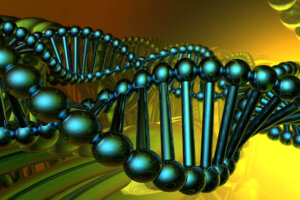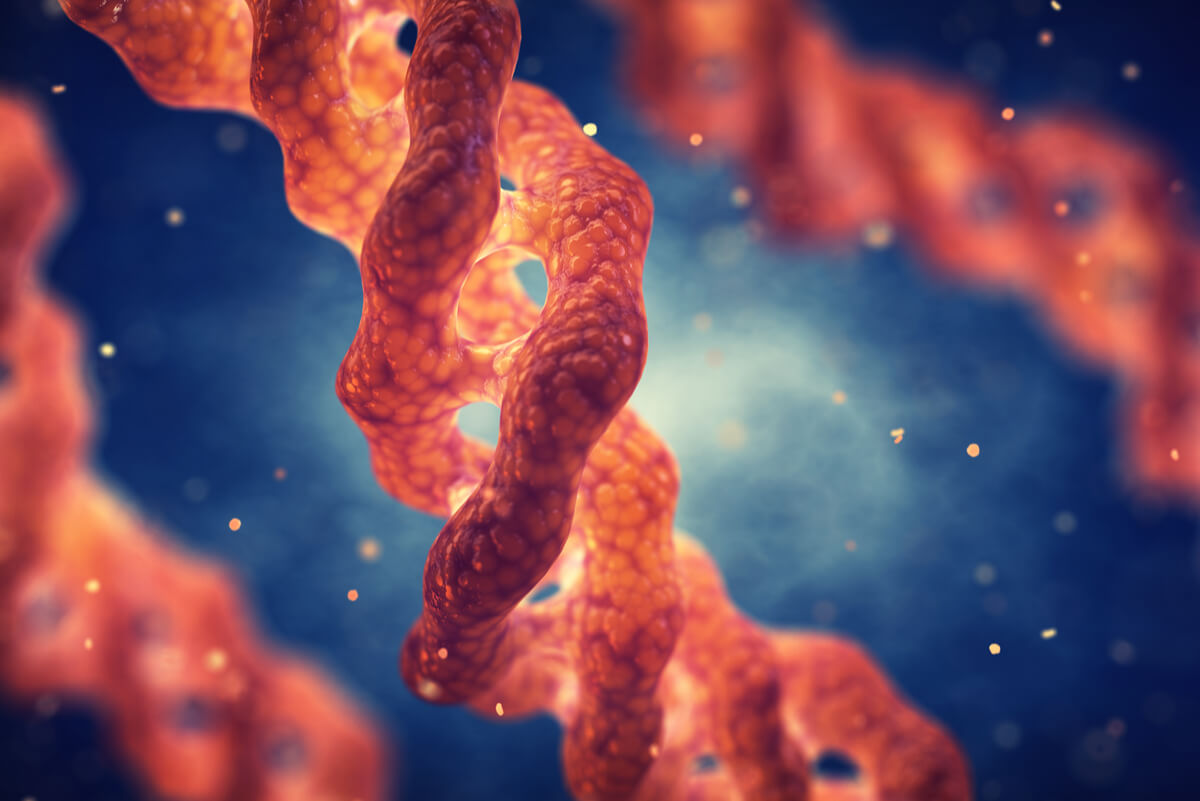The Different Types of DNA

Talking about the different types of DNA isn’t an easy task. Broadly speaking, the characteristics of the molecules are the same, although if we look into it a little deeper, we discover some functionalities or particularities that deserve extra attention.
Think of DNA as an instruction manual that enables cells to perform all of their functions. We find it in almost all cells, from humans to bacteria.
As Nature Education points out, DNA is made up of nucleotides. Each type contains a molecule known as a nitrogen base, and four of these have been identified in total: adenine, thymine, guanine, and cytosine. They’re often abbreviated with their initials; that is, A, T, G and C. Let’s have a look at a summary of the most important types of DNA according to their characteristics.
Types of DNA according to its structure

The first division that we can make of deoxyribonucleic acid is in reference to its primary structure. The two possible types of DNA based on these considerations are as follows.
Single-stranded DNA
In this case, the molecule isn’t made up of two intertwined strands with a helical design, but only one. Because of this, there are no base pairs, but, rather, a linear sequence of DNA. It’s found in viruses, which are called ssDNA viruses.
According to researchers, viruses of this type mainly infect bacteria, archaea, and eukarya. Some are capable of infecting humans and animals, but aren’t associated with major diseases. The best-known are all the viruses of the Parvoviridae family.
Many of these feature a circle-shaped sequence rather than a linear one. Some develop this design during the replication process.
Double-stranded DNA
This is the most familiar type to people, as it consists of two helix-shaped chains linked together through hydrogen bonds, as the National Human Genome Research Institute reminds us.
The researchers point out that the design facilitates the correction of errors, the elimination of damage to the structure of DNA, and of course its replication. Broadly speaking, double-stranded DNA is more stable and complex than single-stranded.
Even so, many viruses manifest this type of DNA. It was discovered on April 25, 1953 by scientists James Watson and Francis Crick.
Types of DNA according to its secondary structure
The most important division of the types of DNA is found if we take into account its secondary structure. In simple terms, differentiation consists of the conformation or folding of the base pairs of the molecule. That is, the angle and external shape (although it’s actually more complex than this). Let’s look at the divisions that scientists follow.
B-DNA
This is the most common of all and is distinguished by its high concentrations of humidity. This is approximately 90% and accepts up to twelve water molecules in each of its grooves. This type of DNA is what is often used in textbooks to represent chains of molecules.
Its direction of rotation is to the right and it can reach a rotation angle of up to 36°. Its design is very stable, in part due to the stacking of nitrogenous bases and the arrangement of hydrogen bonds in their base pairs.
Z-DNA
This is the least common of the three types of DNA, as it only occurs under specific conditions. It is characterized by a long, narrow and uneven structure, with a zigzag pattern (hence its initial). It has approximately twelve base pairs for each turn and is the only one that turns to the left. Its angle of rotation is -30 °.
A-DNA
In this case, the propellers of the structure have a low hydration index. This, in general, is around 70%. It’s only obtained in laboratory samples, with relatively low humidity conditions. It’s characterized by a wide, short shape, with a direction of rotation to the right.
Between its cracks, the chain only accepts five molecules of water, hence its low moisture concentration. It’s most often found in the process of transcription from DNA to RNA. Its angle of twist, on average, is 32°.
Types of DNA according to their functionality
If we look at the function of DNA, we can distinguish two types: coding and non-coding. Keep in mind that it’s the same chain and that it shares the previous characteristics. This means that there’s no separate coding, type B, or double-stranded DNA. It’s a single DNA, only with differentiating characteristics. Keep that in mind when reading the following.
Coding DNA

Only 1% of the DNA strand provides gene information to code for proteins. Proteins are created from information in DNA that serves as a recipe for grouping amino acids together. In this sense, only 1% of DNA allows these instructions to be encoded.
Noncoding DNA
99% of DNA is non-coding. This means that it doesn’t provide useful information for protein design. Of course, this isn’t to say that this section has no function. As the National Human Research Institute reminds us, its job is to regulate the activation of genes and govern the DNA grouping commands on chromosomes, among other things.
For many years, this type of DNA was believed to be junk. Today, even though it’s true that we don’t understand many of its functions, we do know that it plays an important role in the chain.
As you may have already guessed, human DNA is type B double-stranded. It has, in turn, coding and non-coding parts. The mechanism and characteristics that distinguish each type are more technical than described, but they show the enormous complexity behind a chain of molecules. Life itself is only possible thanks to its actions.
Talking about the different types of DNA isn’t an easy task. Broadly speaking, the characteristics of the molecules are the same, although if we look into it a little deeper, we discover some functionalities or particularities that deserve extra attention.
Think of DNA as an instruction manual that enables cells to perform all of their functions. We find it in almost all cells, from humans to bacteria.
As Nature Education points out, DNA is made up of nucleotides. Each type contains a molecule known as a nitrogen base, and four of these have been identified in total: adenine, thymine, guanine, and cytosine. They’re often abbreviated with their initials; that is, A, T, G and C. Let’s have a look at a summary of the most important types of DNA according to their characteristics.
Types of DNA according to its structure

The first division that we can make of deoxyribonucleic acid is in reference to its primary structure. The two possible types of DNA based on these considerations are as follows.
Single-stranded DNA
In this case, the molecule isn’t made up of two intertwined strands with a helical design, but only one. Because of this, there are no base pairs, but, rather, a linear sequence of DNA. It’s found in viruses, which are called ssDNA viruses.
According to researchers, viruses of this type mainly infect bacteria, archaea, and eukarya. Some are capable of infecting humans and animals, but aren’t associated with major diseases. The best-known are all the viruses of the Parvoviridae family.
Many of these feature a circle-shaped sequence rather than a linear one. Some develop this design during the replication process.
Double-stranded DNA
This is the most familiar type to people, as it consists of two helix-shaped chains linked together through hydrogen bonds, as the National Human Genome Research Institute reminds us.
The researchers point out that the design facilitates the correction of errors, the elimination of damage to the structure of DNA, and of course its replication. Broadly speaking, double-stranded DNA is more stable and complex than single-stranded.
Even so, many viruses manifest this type of DNA. It was discovered on April 25, 1953 by scientists James Watson and Francis Crick.
Types of DNA according to its secondary structure
The most important division of the types of DNA is found if we take into account its secondary structure. In simple terms, differentiation consists of the conformation or folding of the base pairs of the molecule. That is, the angle and external shape (although it’s actually more complex than this). Let’s look at the divisions that scientists follow.
B-DNA
This is the most common of all and is distinguished by its high concentrations of humidity. This is approximately 90% and accepts up to twelve water molecules in each of its grooves. This type of DNA is what is often used in textbooks to represent chains of molecules.
Its direction of rotation is to the right and it can reach a rotation angle of up to 36°. Its design is very stable, in part due to the stacking of nitrogenous bases and the arrangement of hydrogen bonds in their base pairs.
Z-DNA
This is the least common of the three types of DNA, as it only occurs under specific conditions. It is characterized by a long, narrow and uneven structure, with a zigzag pattern (hence its initial). It has approximately twelve base pairs for each turn and is the only one that turns to the left. Its angle of rotation is -30 °.
A-DNA
In this case, the propellers of the structure have a low hydration index. This, in general, is around 70%. It’s only obtained in laboratory samples, with relatively low humidity conditions. It’s characterized by a wide, short shape, with a direction of rotation to the right.
Between its cracks, the chain only accepts five molecules of water, hence its low moisture concentration. It’s most often found in the process of transcription from DNA to RNA. Its angle of twist, on average, is 32°.
Types of DNA according to their functionality
If we look at the function of DNA, we can distinguish two types: coding and non-coding. Keep in mind that it’s the same chain and that it shares the previous characteristics. This means that there’s no separate coding, type B, or double-stranded DNA. It’s a single DNA, only with differentiating characteristics. Keep that in mind when reading the following.
Coding DNA

Only 1% of the DNA strand provides gene information to code for proteins. Proteins are created from information in DNA that serves as a recipe for grouping amino acids together. In this sense, only 1% of DNA allows these instructions to be encoded.
Noncoding DNA
99% of DNA is non-coding. This means that it doesn’t provide useful information for protein design. Of course, this isn’t to say that this section has no function. As the National Human Research Institute reminds us, its job is to regulate the activation of genes and govern the DNA grouping commands on chromosomes, among other things.
For many years, this type of DNA was believed to be junk. Today, even though it’s true that we don’t understand many of its functions, we do know that it plays an important role in the chain.
As you may have already guessed, human DNA is type B double-stranded. It has, in turn, coding and non-coding parts. The mechanism and characteristics that distinguish each type are more technical than described, but they show the enormous complexity behind a chain of molecules. Life itself is only possible thanks to its actions.
- Malathi, V. G., & Devi, P. R. ssDNA viruses: key players in global virome. Virusdisease. 2019; 30(1): 3-12.
- Strauss, B. S. Why is DNA double stranded? The discovery of DNA excision repair mechanisms. Genetics. 2018; 209(2): 357-366.
Este texto se ofrece únicamente con propósitos informativos y no reemplaza la consulta con un profesional. Ante dudas, consulta a tu especialista.







